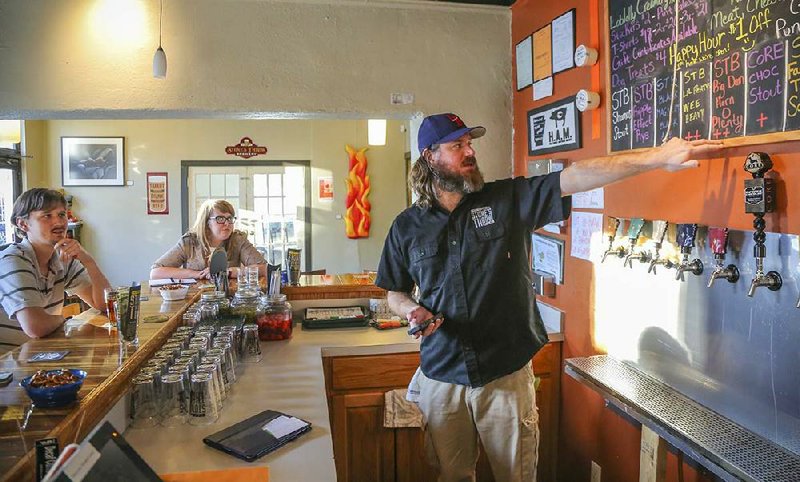It’s just after 4 p.m. Thursday, and behind the bar at Stone’s Throw Brewing in Little Rock, Ian Beard is glued to his smartphone.
Between filling glasses for the first customers trickling in, Beard is sending a photo of the chalkboard that lists the beers available that night to the brewery’s almost 980 followers on Twitter, the social-networking website.
“Every day we open, we let them know what’s on tap,” he said. “That’s essentially the way we get things out.”
Beard and the other three co-owners of Stone’s Throw are no strangers to using online platforms to promote their brew. In fact, the small brewery is the product of a successful online campaign to procure funding for a place to serve their creations.
The owners of Stone’s Throw - Beard, Theron Cash, Brad McLaurin and Shawn Tobin - are local examples of entrepreneurs who are turning to crowd-funding websites, such as Kickstarter.com and Indiegogo.com, to support their small businesses.
Crowd-funding, also popular among artists and musicians, is being used by some new businesses to raise money from the masses - from friends, family, potential customers or even strangers.
Other websites, such as Kiva.org, allow donors to extend loans to entrepreneurs who likely wouldn’t qualify for regular bank financing.
One reason more small businesses are moving to Internet platforms for financial backing is that it’s difficult for new companies to secure funding, said Kathy Deck, director of the Center for Business and Economic Research at the University of Arkansas at Fayetteville.
“Crowd-funding is another solution for small businesses as they try to raise that very, very early capital,” she said. “This is really just the systematization of people going out to ask their friends and families to support their new endeavor.”
“It’s more that technology has made this simpler in some ways,” Deck said, adding that crowd-funding isn’t as easy as it sounds. “There are risks being that this is a new endeavor. You have to make sure you understand where you are in the capital structure.”
And entrepreneurs using crowd-funding websites still need to have a backup plan in case they can’t raise enough funding through the campaign, said Heather Robinette, the consulting and market research manager for the Small Business and Technology Development Center at the University of Arkansas at Little Rock.
“It’s real easy to see crowdfunding as the fix” that works for everybody, but “it’s not necessary for every business,” she said. “They still need a business plan.”
A successful run on a crowd-funding website can provide “market valuation” to a project, said Rose Levy, spokesman for San Francisco based Indiegogo.
This is because it’s “proof that there is a market for your product,” she said. “A lot of people these days are going to banks and not getting loans, and this is a really good way to validate your ideas in the marketplace.”
Stone’s Throw went with Kickstarter in part because the brewery owners could build the business debt-free. When a loan is extended, “the only person invested in your project is the banker,” Beard said.
But with the campaign, Stone’s Throw knew its 264 donors were interested in the project.
“We have all of these people we don’t want to let down and kind of have to answer to,” Beard said.
For supporters, crowdfunding is an opportunity for entrepreneurs to go directly to their audience or customers with their product. But to critics, crowd-funding runs the risk of fraud.
“I think there’s a larger movement toward creative independence,” said Justin Kazmark, spokesman for Brooklyn, N.Y.-based Kickstarter, which has funded more than 55,000 projects via its website. The site does not allow projects to keep the money raised if they don’t meet their goals.
“It’s a lot more democratic, and with that you can experiment a lot more and take risks,” he said about using Kickstarter to finance a project. “You just have a closer connection with the community.”
Stone’s Throw was able to reach its $10,000 goal within three days in part because the owners already had backing from supporters who were following the project months before its Kickstarter campaign started, Beard said.
“It really kind of took off,” he said. “We had a number of folks essentially ready to go.”
Because Stone’s Throw’s campaign was for about 20 days, the owners added a second goal to double its brewing capacity by raising a total of $19,000 to allow for the purchase of a larger fermenter.
In the end, Stone’s Throw raised slightly more than $23,000 when the campaign finished May 8. Two months later, the brewery held an open house for all the Kickstarter campaign donors. And in August, Stone’s Throw opened to the public.
As for future financing for the potential expansion of Stone’s Throw, Beard said there probably won’t be a second Kickstarter campaign.
Between his job at the Old State House Museum and having the brewery open four days a week, there’s not as much time for another campaign.
“As we go into the future though, it’s slowly turning more traditional … We don’t need crowd-funding,” Beard said.
Business, Pages 33 on 01/18/2014
